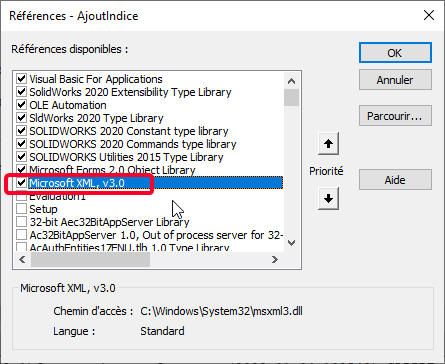For my part I have this in xml:
Option Explicit
'Ajouter la référence à MicrosoftXML v3.0
' Ajout déclaration pour vérif type de documents
Global Const nomfichierXML = "SaveMacroIndice.xml"
Global sPathXML, sPathNameXML As String
Global FileTyp As Long
Global Source As String
Global FichierXml As String
Dim swApp As Object
Dim swModel As SldWorks.ModelDoc2
Dim swPart As SldWorks.PartDoc
Dim swAssembly As SldWorks.AssemblyDoc
Dim Designation As String
Dim Compteur As String
Dim OldIndice As String
Global Indice As String
Dim Filename As String
Dim Filepath As String
Dim File As String
Dim Extension As String
Dim path As String
Dim fso As Object
Dim bRet As Boolean
Dim PathMep As String
Dim swCustProp As CustomPropertyManager
Dim swDocType As Variant
Dim fileerror As Long
Dim filewarning As Long
Dim doc As SldWorks.ModelDoc2
Sub main()
Set swApp = Application.SldWorks
sPathXML = Environ("USERPROFILE") & "\.SaveMacroSldworks\"
sPathNameXML = sPathXML & nomfichierXML
Debug.Print sPathXML & nomfichierXML
'On vérifie si le dossier de sauvegarde existe sinon crétion de ce dossier
If Dir(sPathXML, vbDirectory + vbHidden) = "" Then
Debug.Print "Création du dossier: " & sPathXML
MkDir sPathXML
End If
FichierXml = sPathXML & nomfichierXML
Debug.Print "Fichier xml:" & FichierXml
' on affiche le useforms
UserformOptionsMacro.Show
End Sub
'Ci dessous le userform pour la lecture:
'Initialisation du formulaire
Private Sub UserForm_Initialize()
'position du userform par rapport à la fenêtre (1= centré/fenêtre 2= centré écran, 3=angle en haut à gauche)
'Me.StartUpPosition = 0
Me.StartUpPosition = 2 - CenterScreen
'UserformOptionsMacro.Left = Activewindow.Left + Activewindow.Width / 2 - UserformOptionsMacro.Width / 2
'initialisation du userform
CommandButtonExec.SetFocus
'On parcours le fichier xml pour récupérer les valeures sauvegardées.
Debug.Print "Fichier xml:" & FichierXml
If Dir(FichierXml) = "" Then
Debug.Print "Pas de fichier xml trouvé -> les valeures par défaut seront sélectionnées"
CheckBoxLectureSeule = True
CheckBoxCouleur = True
CheckBoxDesignation = True
CheckBoxCacherPlan = True
CheckBoxCacherPièce = True
CheckBoxRevision = False
Else
Debug.Print "Fichier xml trouvé -> les valeures sauvegardées seront sélectionnées"
Dim oXML As MSXML2.DOMDocument
Dim oNode As MSXML2.IXMLDOMNode
Set oXML = New MSXML2.DOMDocument
oXML.async = False
oXML.Load FichierXml
For Each oNode In oXML.documentElement.childNodes
For Each osubnode In oNode.childNodes
Debug.Print " - " & oNode.baseName, "=" & osubnode.Text
If oNode.baseName = "CheckBoxLectureSeule" Then CheckBoxLectureSeule = osubnode.Text
If oNode.baseName = "CheckBoxCouleur" Then CheckBoxCouleur = osubnode.Text
If oNode.baseName = "CheckBoxDesignation" Then CheckBoxDesignation = osubnode.Text
If oNode.baseName = "CheckBoxCacherPlan" Then CheckBoxCacherPlan = osubnode.Text
If oNode.baseName = "CheckBoxCacherPièce" Then CheckBoxCacherPièce = osubnode.Text
If oNode.baseName = "CheckBoxRevision" Then CheckBoxRevision = osubnode.Text
Next
Next
End If
End Sub
To read:
To write:
Sub CreationCompleteXML() 'Création du fichier xml de sauvegardes des paramètres du menu options
Dim oXML As Object
Dim oNode As Object
Dim root As Object
Dim elem As Object
Dim rel As Object
Set oXML = New MSXML2.DOMDocument
Set oNode = oXML.createProcessingInstruction("xml", "version=""1.0"" encoding=""ISO-8859-1""")
oXML.appendChild oNode
With oXML.appendChild(oXML.createElement("OPTIONS"))
.appendChild oXML.createTextNode(vbCrLf)
.appendChild oXML.createTextNode(vbTab)
With .appendChild(oXML.createElement("CheckBoxLectureSeule"))
.Text = IIf(UserformOptionsMacro.CheckBoxLectureSeule.Value = 0, "False", "True")
End With
.appendChild oXML.createTextNode(vbCrLf)
.appendChild oXML.createTextNode(vbCrLf)
.appendChild oXML.createTextNode(vbTab)
With .appendChild(oXML.createElement("CheckBoxCacherPièce"))
.Text = IIf(UserformOptionsMacro.CheckBoxCacherPièce.Value = 0, "False", "True")
End With
.appendChild oXML.createTextNode(vbCrLf)
.appendChild oXML.createTextNode(vbTab)
With .appendChild(oXML.createElement("CheckBoxCacherPlan"))
.Text = IIf(UserformOptionsMacro.CheckBoxCacherPlan.Value = 0, "False", "True")
End With
.appendChild oXML.createTextNode(vbCrLf)
.appendChild oXML.createTextNode(vbTab)
With .appendChild(oXML.createElement("CheckBoxDesignation"))
.Text = IIf(UserformOptionsMacro.CheckBoxDesignation.Value = 0, "False", "True")
End With
.appendChild oXML.createTextNode(vbCrLf)
.appendChild oXML.createTextNode(vbTab)
With .appendChild(oXML.createElement("CheckBoxCouleur"))
.Text = IIf(UserformOptionsMacro.CheckBoxCouleur.Value = 0, "False", "True")
End With
.appendChild oXML.createTextNode(vbCrLf)
.appendChild oXML.createTextNode(vbTab)
With .appendChild(oXML.createElement("CheckBoxRevision"))
.Text = IIf(UserformOptionsMacro.CheckBoxRevision.Value = 0, "False", "True")
End With
.appendChild oXML.createTextNode(vbCrLf)
End With
oXML.Save FichierXml
End Sub
I also have this snippet of code to write in a csv.
For the reading part I'll let you do some research, it's possible but I have nothing at hand:
'*** Macro à utiliser dans un assemblage afin de récuperer dans le bloc note un fichier texte avec la liste de toutes les pièces exclus de la nomenclature***
Sub main()
Dim swModel As SldWorks.ModelDoc2
Dim swPart As SldWorks.PartDoc
Dim bRet As Boolean
Dim MyPath As String
Dim MyFolder As String
Set swApp = Application.SldWorks
Set Assembly = swApp.ActiveDoc
Set myAsy = Assembly
Set swModel = swApp.ActiveDoc
'**********Chemin d'export MEP**********
'*******Récup chemin existant***********
MyFolder = CurDir$
Debug.Print "Current Folder = " & MyFolder
soutputfile = MyFolder & "\Exclu.txt"
Debug.Print soutputfile
Set fso = CreateObject("Scripting.FileSystemObject")
'On créer le fichier .txt
Set FileList = fso.CreateTextFile(soutputfile, 8, -2)
myCmps = myAsy.GetComponents(False)
'On boucle sur tous lec composants
For i = 0 To UBound(myCmps)
Set myCmp = myCmps(i)
'On écrit le nom de chaque pièce ou assemblage excle de la nomenclature
If myCmp.ExcludeFromBOM Then
FileList.Write myCmp.Name2 & vbCrLf
End If
Next i
Or again:
https://www.codestack.net/solidworks-api/document/assembly/components/export-positions/
Or also:
https://chandoo.org/forum/threads/how-to-read-data-from-a-csv-file-and-write-the-same-in-the-active-worksheet-using-macro.37896/
Hoping to have put you on the right track for your needs.
